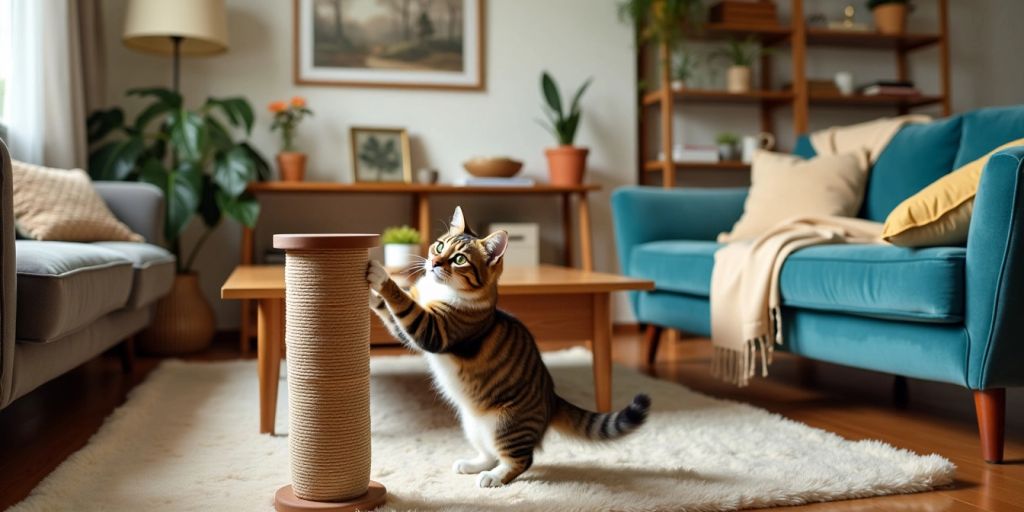Cats love to scratch, and while it's a natural behavior, it can be frustrating when they target your furniture. Understanding why cats scratch and how to redirect this behavior can help protect your home while keeping your feline friend happy. Here are some effective strategies to manage your cat's scratching habits.
Key Takeaways
- Cats scratch to keep their claws healthy and mark their territory.
- Providing suitable scratching posts can help redirect their scratching away from furniture.
- Using deterrents like sprays and protective covers can discourage cats from scratching furniture.
- Positive reinforcement is key; reward your cat for using their scratching posts instead of your furniture.
- Regularly trimming your cat's nails can minimize damage to your furniture.
Understanding Cat Scratching Behavior
Reasons Cats Scratch Furniture
Cats scratch for several reasons. It’s a natural behavior that helps them communicate and express themselves. Here are some key reasons:
- Claw Maintenance: Scratching helps cats remove the dead outer layers of their claws.
- Territory Marking: Cats leave their scent and visual marks to claim their space.
- Stress Relief: Scratching can help cats relieve stress and express emotions.
- Stretching: It’s a great way for them to stretch their muscles and keep fit.
The Importance of Scratching
Understanding why cats scratch is crucial. If they don’t have proper scratching surfaces, they might turn to your furniture. Providing them with appropriate options is essential to prevent damage to your home.
How Scratching Benefits Cats
Scratching is not just about destruction; it’s beneficial for your cat’s well-being. Here’s how:
- Physical Exercise: Keeps their muscles toned and healthy.
- Mental Stimulation: Engaging in scratching can keep their minds active.
- Emotional Health: Helps them express feelings and reduce anxiety.
Providing your cat with the right scratching surfaces can unlock the secret to a vibrant, joy-filled life for your feline friend!
Creating a Scratching-Friendly Environment
Choosing the Right Scratching Post
When selecting a scratching post, consider your cat's preferences. Cats often prefer posts that are tall and sturdy, allowing them to stretch fully. Look for materials like sisal or cardboard, which are appealing to cats. Here are some tips:
- Height: Ensure the post is tall enough for your cat to stretch.
- Material: Choose durable materials that withstand scratching.
- Stability: The post should not tip over easily.
Placement of Scratching Posts
The location of the scratching post is crucial. Place it in areas where your cat spends most of their time. Here are some ideal spots:
- Near their favorite resting place.
- Close to furniture they usually scratch.
- In high-traffic areas where they feel comfortable.
Encouraging Use of Scratching Surfaces
To encourage your cat to use the scratching post, you can:
- Use catnip: Sprinkle some on the post to attract your cat.
- Praise and reward: Whenever your cat uses the post, give them treats or affection.
- Redirect behavior: If you catch them scratching furniture, gently guide them to the post.
Remember, cleaning the areas where your cat scratches can help remove scents that attract them back. First, make sure to clean the objects or areas with soap and water to remove the communication marking scents left by your cat's paws. Then apply the product to deter them from scratching those spots again.
Utilizing Deterrents to Stop Cat Scratching
Feline-Repellent Sprays
One effective way to keep your cat from scratching furniture is to use a feline-repellent spray. You can make your own by mixing equal parts of white vinegar and water, then adding fresh lemon juice and a sprig of rosemary. Cats dislike these scents, so spraying this mixture on furniture can help deter them from scratching. Just remember, never spray directly on your cat as it can irritate them.
Covering Furniture with Protective Materials
If your cat has already started scratching your furniture, it’s a good idea to cover their favorite spots. For example, you can use thick fabric to protect couch corners or find special covers for leather furniture. This will help keep your cat away from those areas.
Making Furniture Less Attractive
To discourage scratching, you can make your furniture less appealing. Here are some methods:
- Apply double-sided tape or tinfoil to the areas your cat likes to scratch. The texture and sound will make scratching less enjoyable.
- Remove any items that your cat enjoys playing with near the furniture, as this can attract them to scratch.
By using these deterrents, you can protect your furniture while keeping your cat happy. Remember, the goal is to redirect their scratching behavior to appropriate surfaces.
| Deterrent Method | Effectiveness | Notes |
|---|---|---|
| Feline-Repellent Spray | Moderate | Use on furniture, not on cats |
| Protective Covers | High | Best for favorite scratching spots |
| Double-Sided Tape or Tinfoil | High | Makes scratching less fun |
Positive Reinforcement Techniques
Rewarding Desired Behavior
One of the best ways to train your cat is through positive reinforcement. Whenever you see your cat using their scratching post or pad, give them praise, pets, or treats. This will help them understand that scratching the right surfaces is a good thing.
Redirecting Attention to Scratching Posts
If you catch your cat scratching your furniture, don’t yell or scare them. Instead, gently move them to their scratching post. Once they start using it, reward them immediately. This helps them learn that scratching the post is what you want them to do.
Using Catnip to Encourage Scratching
Many cats love catnip, and you can use this to your advantage. Sprinkle some dried catnip on their scratching posts or spray them with catnip oil. This will make the posts more appealing and encourage your cat to use them instead of your furniture.
Remember, cats learn best when they are rewarded for good behavior rather than punished for bad behavior. By focusing on what they do right, you can help them develop better habits.
| Technique | Description |
|---|---|
| Positive Reinforcement | Reward your cat for using the scratching post with treats or praise. |
| Gentle Redirection | Calmly move your cat to the scratching post if they scratch furniture. |
| Catnip Attraction | Use catnip to make scratching posts more appealing to your cat. |
Maintaining Your Cat's Claws
Trimming Your Cat's Nails
Keeping your cat's claws trimmed is essential for protecting your furniture. Regularly trimming your cat's nails can significantly reduce the damage they cause. Here’s how to do it:
- Gently hold your cat and inspect their claws.
- Identify the quick, which is the pink part of the nail.
- Carefully trim just the tip of the nail, avoiding the quick to prevent pain and bleeding.
If your cat is too squirmy, consider taking them to a vet or groomer for help.
Using Nail Caps for Protection
Nail caps, like Soft Paws, are a great option for protecting your furniture. These caps fit over your cat's claws and allow them to scratch without causing damage. They usually last about a month and can be applied by you or your vet. This is a humane alternative to declawing and can help keep your home safe.
Regular Grooming Practices
In addition to trimming and using nail caps, regular grooming is important. Here are some tips:
- Brush your cat’s fur to reduce shedding.
- Check their paws for any debris or issues.
- Make grooming a positive experience by rewarding your cat with treats.
Maintaining your cat's claws is not just about protecting your furniture; it’s also about keeping your cat happy and healthy.
By following these steps, you can help ensure that your cat's scratching behavior is managed effectively while keeping your home intact. Remember, placing scratch posts in areas your cat frequents can also help redirect their scratching habits!
Alternative Solutions for Persistent Scratching
Investing in Scratch Pads
Providing your cat with scratch pads can be a great way to redirect their scratching behavior. These pads come in various materials and shapes, making them appealing to different cats. Here are some options:
- Cardboard pads: Affordable and often favored by cats.
- Sisal pads: Durable and great for claw maintenance.
- Carpet pads: Mimic the texture of furniture, which some cats prefer.
Exploring Cat Furniture Options
Consider investing in specialized cat furniture that encourages scratching. Look for:
- Multi-level cat trees: These provide various scratching surfaces and play areas.
- Sofa-style scratchers: Designed to look like furniture, they can satisfy your cat's urge to scratch while protecting your actual furniture.
Consulting with a Veterinarian
If scratching persists despite your efforts, it might be time to consult a veterinarian. They can help determine if there are underlying behavioral issues or suggest additional strategies.
Remember, scratching is a natural behavior for cats, and finding the right solutions can help keep both your furniture safe and your feline friend happy!
Understanding the Risks of Declawing
Health Risks Associated with Declawing
Declawing is not just a simple nail trim; it involves removing the last bone of each toe. This can lead to serious health issues, including:
- Infection: The surgical site can become infected, leading to pain and complications.
- Nerve Damage: There is a risk for long-term nerve trauma, which can affect your cat's mobility.
- Behavioral Changes: Cats may become more aggressive or fearful after the procedure.
Ethical Considerations
Many veterinarians and animal welfare organizations argue that declawing is inhumane. It removes a cat's natural ability to scratch, which is essential for their well-being. Instead of declawing, it’s better to provide alternatives for scratching.
Humane Alternatives to Declawing
Instead of resorting to declawing, consider these options:
- Regular Nail Trimming: Keep your cat's nails short to minimize damage.
- Scratching Posts: Provide various scratching surfaces to redirect their behavior.
- Nail Caps: These can be applied to protect furniture while allowing your cat to scratch naturally.
Declawing should be a last resort, as it can lead to long-term pain and behavioral issues. The American Veterinary Medical Association suggests that “declawing of domestic cats should be considered only in extreme cases.”
Final Thoughts on Managing Cat Scratching
In conclusion, while you can't completely stop your cat from scratching, you can definitely manage it. By understanding why cats scratch and providing them with suitable alternatives, you can protect your furniture and keep your feline friend happy. Regularly trimming their claws, offering scratching posts, and using deterrent sprays can make a big difference. Remember, positive reinforcement is key—praise your cat when they use their scratching post instead of your couch. With patience and the right strategies, you can create a home that works for both you and your cat.
Frequently Asked Questions
Why do cats scratch furniture?
Cats scratch furniture to keep their claws healthy, mark their territory, and stretch their muscles. It's a natural behavior for them.
How can I stop my cat from scratching my couch?
You can stop your cat by providing scratching posts, using deterrent sprays, and rewarding them when they use the posts instead of the furniture.
Is declawing a good option to prevent scratching?
No, declawing is not a good option. It can cause pain and health issues for your cat. There are better, humane ways to manage scratching.
What should I do if my cat won’t use the scratching post?
Try placing the scratching post in a visible area, using catnip to attract them, or rewarding them when they use it.
Are there products to protect my furniture from scratches?
Yes, there are protective covers, sprays, and sticky tape you can use to deter your cat from scratching your furniture.
How often should I trim my cat’s nails?
It's best to trim your cat’s nails every few weeks to keep them short and prevent damage to your furniture.



